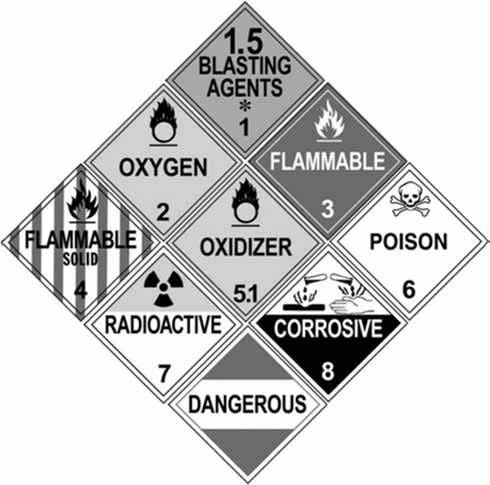You’re out on the loading dock, flipping through manifests while the crew preps the forklifts. In the meantime, diesel from a generator is trickling towards a storm drain. Fast forward, you’re facing fines, a hefty cleanup tab, and your safety record just took a hit. With more mobile and on-site fuel delivery, knowing diesel hazard classifications is crucial for safe storage, handling, and transport.
But “What class is diesel fuel?” you may ask, or “Is diesel fuel combustible?” The reply is not so simple. That’s why this article shares diesel’s hazards, its classifications, and how to handle it safely to prevent mistakes and maintain compliance. So, have a look!
key takeaways
Is diesel a hazardous material? Well, yes, it totally is. Diesel is a flammable liquid that sits under Class 3 hazard. Besides catching fire, it leeches into soil and water and causes health issues due to skin contact or fume inhalation. Most of these hazards are downplayed, the repercussions of which are spills, environmental defilement, as well as penalties by OSHA, DOT, or EPA.
However, when it comes to safe handling of diesel, there are proper containers, labels, spill retention, and staff training, among other laws that have to be observed. Failure to follow them and you are facing a heavy fine, costly clean up, and a load of wasted time. However, partnering with a fuel provider that does not compromise on safety and compliance rules like Rhino Fuel would be a great way to reduce these hazards.

What Is a Hazardous Material?
Toxic substances, which are either biological, chemical, radiological, or physical, are a haza\rd to both humans and creatures, as well as the environment. When you ask, “Is diesel considered a hazardous material?” the short answer is pretty much yes. However, the correct reply is subject to the properties of the diesel, its use, and regulation. The definition and regulation of hazardous materials are prescribed by a number of agencies in the U.S.
Workplace hazards are addressed by the Occupational Safety and Health Administration (OSHA), and the U.S. Department of Transportation (DOT) takes care of transport hazards. While the Environmental Protection Agency (EPA) rates the environmental perils from spills.
The National Fire Protection Association (NFPA) classifies hazards for determining the way to pack, label, handle, and respond in case of an emergency. When delivering diesel fuel, Rhino Fuel complies with all diesel fuel hazards regulations to ensure that people, property, and the environment are not exposed to non-compliant diesel delivery.
Is Diesel a Hazardous Material?
The answer is yes, diesel is considered a hazardous material subject to the DOT hazmat regulations. It is listed on the Hazardous Materials Table (49 CFR 172) and is categorized based on quantity, use, and regulations. But in transport, diesel fuel is Hazard Class 3 (combustible liquids) with UN 1202.
In addition, it undergoes additional regulations by the relevant agencies like the DOT, OSHA, and the EPA when stored in bulk or in transportation. Here’s a detailed explanation of diesel hazard classification, and how storing and transporting it in bulk requires different regulations:
Diesel Fuel Hazard Class Explained
When its flash point is 38°C or higher, diesel is regarded as a Class 3 combustible liquid according to DOT. The flash point is the lowest temperature at which a liquid provides sufficient vapor to ignite when surrounded by a spark or a flame. Diesel’s flash point is more than 38°C, with the lower limit of 52°C to the upper limit of 96°C, which places this fuel in the group of combustible liquids.
Diesel does not have a flammable label on it, as far as the federal regulation of hazardous materials is concerned. It is also safer to manage at room temperature. However, it may flare up, once heated above its flash point, particularly in a confined space or burned near a source of flame. Nevertheless, it is still less volatile than an inflammable liquid such as gasoline, which has a flash point temperature of -45 °C and is highly flammable at room temperature.
Though diesel can be defined as one of the flammable liquids in some Safety Data Sheets (SDS). In addition, under the OSHA and NFPA standards, diesel is categorized on the basis of flash point. It is not regarded as a Category 1 or 2 (flash point between 23°C and 35°C) flammable liquid due to its flash point being greater than 23°C.
All diesel types are usually Category 3 (23-60°C nominal flash point range), although the most conventional type is Category 4 (60-93°C range). Diesel is also a Category 4 flammable liquid according to the Globally Harmonized System (GHS).
Bulk Transport of Diesel
Containers that are less than 119 gallons with diesel reclassified as combustible are exempt from most of the rules of hazardous materials, such as placarding. However, above 119 gallons, placarding must be carried out. Diesel is required to be labeled as “COMBUSTIBLE” (or “FLAMMABLE” on not reclassified), e.g., on 3,000-gallon tanks or 200-gallon IBCs.
Nevertheless, any diesel in the fuel tanks of an internal combustion engine is always said to be hazardous regardless of size or rearrangement. In addition to that, the driver is allowed to transport 119 gallons per container without a HAZMAT endorsement. Bulk packaging contains over 119 gallons, whereas packaging in non-bulk has less than this. Though the maximum is usually 1,000 gallons in total, some rules restrict loads to 500 gallons.

Common Diesel Fuel Hazards
Diesel spills impose harm on soil and water by changing soil chemistry and killing the microorganisms that make it hard to grow plants. Spills can happen due to a leakage, by mistake, or improper disposal. There is also a possibility of diesel vapors migrating into buildings.
We’re talking fire, and health-related risks such as nausea, headaches, and lung damage here. Long-term effects can also harm the kidneys and induce cancer. Besides, diesel causes skin irritation on contact and is flammable, which presents fire hazards, especially if it’s next to a heat source, generators, or sparks.
How to Handle Diesel Safely?
You can handle diesel safely by following safe storage and proper transport, holding regular safety audits, and crew training. Here’s how:
1. Safe Storage Guidelines
Diesel should be stored in an area that is cool and has a free flow of air to the outside if stored indoors. It should be kept away from contact with any sparks, flame, or heat, as well as it must be contained in approved containers. Remove tanks close to wells, springs, or flood zones and use spill trays or a double-walled tank with a capacity of 110% of the main tank.
Also, ground tanks to reduce static, label them clearly, and keep fire safety equipment nearby. Store out of sunlight, maintain containers, and secure outdoor tanks. Tanks up to 3,500 liters should be 1.8 meters from buildings, and larger tanks should be 6 meters away.
2. Proper Transport
Follow DOT rules for transporting diesel, as it is classified as hazardous. Bulk loads need placards, and tanks must be fixed to the vehicle with a maximum capacity of 500 gallons. Also, employ approved containers or safety cans, with only one safety can per vehicle.
Vehicles must have two dry chemical fire extinguishers rated 10A:60B:C or higher. Keep spill kits available and avoid carrying diesel with other cargo, except for two transport units up to 500 gallons each.
3. Holding Regular Safety Audits
Hold safety audits at regular intervals to inspect the presence of fuel tanks, and fill points labeling, the PPE signs, and spill kits. You should keep track of the unusual rise in fuel usage and observe inventory controls to monitor quantity received, dispensed, and recorded.
Furthermore, diesel equipment should be inspected to prevent spills, and containers should be clean and suitable before loading. Periodic reports should outline any issues and suggest solutions.
4. Training Your Crew
Every personnel dealing with diesel should be trained on how to handle diesel safely, store it, and respond to any emergency. They should be trained on things like DOT requirements, company safety rules, emergency spill plans, safe fueling, safe use of trucks, and all other equipment.
Moreover, the new drivers must receive instructions under supervision, and you should hold meetings frequently to discuss the safety performance and the updates. There should also be documentation for spill incidents, including the quantity spilled, the method of cleanup, and where the contaminated materials are taken to.
What Happens If You Don’t Comply?
Failure to observe safe diesel handling practices may lead to huge fines, idle time, and lawsuits. Serious violations can reach up to $16,550, and willful and repeated ones up to $165,144. DOT penalties for infringement on hazardous materials regulations are between $617 and $238,809. The EPA may also initiate very stiff fines in cases of spills or emissions violations.
For example, Rudy’s Performance Parts in North Carolina was fined $10 million in 2024. The company was producing “defeat devices” for diesel trucks to disable the EPA emissions controls. In 2023, another company, Sinister Diesel, was fined $1 million because it had manipulated emissions devices.
Other consequences of the non-compliance include shutdown of operations and high costs when inspection or spill cleanup is in progress. Mishandling is also subject to legal claims due to environmental and property damage, or even health problems. Besides, insurance is unlikely to cover claims due to pollution, and premiums may be increased because of safety violations, or even policies may be canceled.
Conclusion: Need a Fuel Partner That Keeps Safety And Compliance Top of Mind?
Diesel is treated as a hazardous substance. Therefore, its handling, storage, and transportation have to be carried out safely. Rules should be followed to avoid accidents and fines as well as environmental degradation. Whether it is storage distances to DOT transport constraints, or worker training, safety measures will save lives, assets, and the environment.
Rhino Fuel provides off-road and on-site diesel delivery while keeping your fleet’s safety and diesel handling compliance at the top. Our firm complies with any federal and state demands. Thus, there is no fear of penalties. We do mobile fueling, scheduled deliveries, and emergency replenishment, 24 hours per day, with safety, timeliness, and savings being our priority. Contact us to request a quotation or make a bulk diesel order for your fleet!
frequently asked questions
Is diesel a hazardous substance?
Yes. Diesel is a hazardous material and is listed on the Hazardous Materials Table. It can catch fire and cause an explosion, health and environmental harm.
How hazardous is diesel fuel?
Diesel is combustible, which means, in short, it could be ignited by fire. In addition, skin rashes, breathing problems, lightheadedness, nausea, and headaches can materialize due to either touching it or inhaling it. In the long term, it can harm the kidneys and induce blood clotting. Diesel leaks could also pollute soil and water.
What category is diesel fuel?
Diesel fuel is classified by its flash point and packaging. It can be Class 3 or Class 4 based on its flashpoint. When its flash point is at 38 °C or more, it’s considered combustible.
What is the hazardous material code for diesel?
What type of fuel is diesel?
Diesel is a liquid fuel utilized in engines that burn fuel through compression. It’s packed with 10 to 22 carbon atoms (hydrocarbons) and is created from crude oil. There’s usually a bit of nitrogen, sulfur, and oxygen mixed in, too.


Leave a Reply